InSAR Coherence Linked to Soil Moisture, Water Level and Precipitation on a Blanket Peatland in Scotland
Highlights
- Sentinel-1 InSAR coherence is strongly and seasonally related to peatland soil moisture, with the highest linear relationships in spring and summer, and strongest at intact bogs.
- Water level–InSAR coherence relationships are weaker and often out-of-phase, while precipitation timing is strongly cross-correlated with InSAR coherence but not linearly related.
- InSAR coherence provides a useful remotely sensed indicator of peatland soil moisture and hydrological seasonality, especially when between peatlands of different condition.
- Combining InSAR coherence with ground data can enhance peatland monitoring and support restoration assessment in blanket bog ecosystems.
Abstract
1. Introduction
1.1. InSAR Coherence
1.2. InSAR and Hydrology
2. Materialsand Methods
2.1. Data Acquisition
2.1.1. InSAR Coherence Data
2.1.2. Shorter-Term Munsary and Knockfin Heights Ground Data
2.1.3. Longer-Term Munsary Ground Data
2.1.4. Wick Weather Data
2.2. Data Processing
3. Results
3.1. Soil Moisture and InSAR Coherence
3.2. Water Level and InSAR Coherence
3.3. Precipitation and InSAR Coherence
4. Discussion
4.1. Variations in Soil Moisture and InSAR Coherence
4.2. Variations in Water Level and InSAR Coherence
4.3. Variations in Precipitation and InSAR Coherence
4.4. Future Work
5. Conclusions
Author Contributions
Funding
Institutional Review Board Statement
Informed Consent Statement
Data Availability Statement
Acknowledgments
Conflicts of Interest
Abbreviations
| SAR | Synthetic Aperture Radar |
| InSAR | Interferometric Synthetic Aperture Radar |
| SLC | Single Look Complex |
| PSM | Peat Surface Motion |
| ASF | Alaskan Satellite Facility |
| LULC | Land Use Land Cover |
References
- Wilkinson, S.L.; Andersen, R.; Moore, P.A.; Davidson, S.J.; Granath, G.; Waddington, J.M. Wildfire and degradation accelerate northern peatland carbon release. Nat. Clim. Change 2023, 13, 456–461. [Google Scholar] [CrossRef]
- Joosten, H.; Clarke, D. Wise Use of Mires and Peatlands-Background and Principles Including a Framework for Decision-Making; International Mire Conservation Group and International Peat Society, Saarijärven Offset Oy: Saarijärvi, Finland, 2002; pp. 1–304. [Google Scholar]
- Page, S.E.; Baird, A.J. Peatlands and Global Change: Response and Resilience. Annu. Rev. Environ. Resour. 2016, 41, 35–57. [Google Scholar] [CrossRef]
- Flynn, R.; Mackin, F.; Renou-Wilson, F. Towards the Quantification of Blanket Bog Ecosystem Services to Water; Technical Report; Environmental Protection Agency: Washington, DC, USA, 2021. [Google Scholar]
- Hughes, R.; Anderson, R.; Cowie, N.R.; Gullett, P.R.; Hancock, M.H.; Klein, D.; Littlewood, N.; Martin-Walker, A.; Pravia, A.; Stagg, P.; et al. Hydrological and vegetation change during peatland restoration at ex-forested sites in a blanket bog ecosystem. J. Appl. Ecol. 2025, 62, 2357–2372. [Google Scholar] [CrossRef]
- Smith, L. Satellite remote sensing of river inundation area, stage, and discharge: A review. Hydrol. Process. 1997, 11, 1427–1439. [Google Scholar] [CrossRef]
- Campbell, J.; Wynne, R.; Thomas, V. Introduction to Remote Sensing, 6th ed.; The Guilford Press: New York, NY, USA, 2022. [Google Scholar]
- White, L.; Brisco, B.; Dabboor, M.; Schmitt, A.; Pratt, A. A collection of SAR methodologies for monitoring wetlands. Remote Sens. 2015, 7, 7615–7645. [Google Scholar] [CrossRef]
- Töyrä, J.; Pietroniro, A. Towards operational monitoring of a northern wetland using geomatics-based techniques. Remote Sens. Environ. 2005, 97, 174–191. [Google Scholar] [CrossRef]
- Bechtold, M.; Tiemeyer, B.; Laggner, A.; Leppelt, T.; Frahm, E.; Belting, S. Large-scale regionalization of water table depth in peatlands optimized for greenhouse gas emission upscaling. Hydrol. Earth Syst. Sci. 2014, 18, 3319–3339. [Google Scholar] [CrossRef]
- Bechtold, M.; Schlaffer, S.; Tiemeyer, B.; De Lannoy, G. Inferring water table depth dynamics from ENVISAT-ASAR C-band backscatter over a range of peatlands from deeply-drained to natural conditions. Remote Sens. 2018, 10, 536. [Google Scholar] [CrossRef]
- Millard, K.; Richardson, M. Quantifying the relative contributions of vegetation and soil moisture conditions to polarimetric C-Band SAR response in a temperate peatland. Remote Sens. Environ. 2018, 206, 123–138. [Google Scholar] [CrossRef]
- Canisius, F.; Brisco, B.; Murnaghan, K.; Van Der Kooij, M.; Keizer, E. SAR backscatter and InSAR coherence for monitoring wetland extent, flood pulse and vegetation: A study of the Amazon lowland. Remote Sens. 2019, 11, 720. [Google Scholar] [CrossRef]
- Srivastava, S.K.; Jayaraman, V. Relating Interferometric Signature of Repeat Pass ERS-1 SAR Signals to Dynamic Land Cover Changes. Acta Astronaut. 2001, 48, 37–44. [Google Scholar] [CrossRef]
- Brisco, B.; Murnaghan, K.; Wdowinski, S.; Hong, S.H. Evaluation of RADARSAT-2 Acquisition Modes for Wetland Monitoring Applications. Can. J. Remote Sens. 2015, 41, 431–439. [Google Scholar] [CrossRef]
- Di Baldassarre, G.; Schumann, G.; Brandimarte, L.; Bates, P. Timely Low Resolution SAR Imagery To Support Floodplain Modelling: A Case Study Review. Surv. Geophys. 2011, 32, 255–269. [Google Scholar] [CrossRef]
- Hrysiewicz, A.; Holohan, E.P.; Donohue, S.; Cushnan, H. SAR and InSAR data linked to soil moisture changes on a temperate raised peatland subjected to a wildfire. Remote Sens. Environ. 2023, 291, 113516. [Google Scholar] [CrossRef]
- Barrett, B.; Whelan, P.; Dwyer, N. The Use of C-and L-Band Repeat-Pass Interferometric SAR Coherence for Soil Moisture Change Detection in Vegetated Areas. Open Remote Sens. J. 2012, 5. [Google Scholar] [CrossRef]
- Millard, K.; Kirby, P.; Nandlall, S.; Behnamian, A.; Banks, S.; Pacini, F. Using growing-season time series coherence for improved peatland mapping: Comparing the contributions of Sentinel-1 and RADARSAT-2 coherence in full and partial time series. Remote Sens. 2020, 12, 2465. [Google Scholar] [CrossRef]
- Alshammari, L.; Large, D.; Boyd, D.; Sowter, A.; Anderson, R.; Andersen, R.; Marsh, S. Long-term peatland condition assessment via surface motion monitoring using the ISBAS DInSAR technique over the Flow Country, Scotland. Remote Sens. 2018, 10, 1103. [Google Scholar] [CrossRef]
- Alshammari, L.; Boyd, D.; Sowter, A.; Marshall, C.; Andersen, R.; Gilbert, P.; Marsh, S.; Large, D. Use of Surface Motion Characteristics Determined by InSAR to Assess Peatland Condition. J. Geophys. Res. Biogeosciences 2020, 125, e2018JG004953. [Google Scholar] [CrossRef]
- Bradley, A.; Andersen, R.; Marshall, C.; Sowter, A.; Large, D. Identification of typical ecohydrological behaviours using InSAR allows landscape-scale mapping of peatland condition. Earth Surf. Dyn. 2022, 10, 261–277. [Google Scholar] [CrossRef]
- Marshall, C.; Sterk, H.; Gilbert, P.; Andersen, R.; Bradley, A.; Sowter, A.; Marsh, S.; Large, D. Multiscale Variability and the Comparison of Ground and Satellite Radar Based Measures of Peatland Surface Motion for Peatland Monitoring. Remote Sens. 2022, 14, 336. [Google Scholar] [CrossRef]
- Brisco, B.; Ahern, F.; Murnaghan, K.; White, L.; Canisus, F.; Lancaster, P. Seasonal change in wetland coherence as an aid to wetland monitoring. Remote Sens. 2017, 9, 158. [Google Scholar] [CrossRef]
- Prati, C.; Rocca, F. Improving slant-range resolution with multiple SAR surveys. IEEE Trans. Aerosp. Electron. Syst. 1993, 29, 135–143. [Google Scholar] [CrossRef]
- Olesk, A.; Praks, J.; Antropov, O.; Zalite, K.; Arumäe, T.; Voormansik, K. Interferometric SAR coherence models for Characterization of hemiboreal forests using TanDEM-X dssata. Remote Sens. 2016, 8, 700. [Google Scholar] [CrossRef]
- Hagberg, J.O.; Ulander, L.M.; Askne, J. Repeat-pass SAR interferometry over forested terrain. IEEE Trans. Geosci. Remote Sens. 1995, 33, 331–340. [Google Scholar] [CrossRef]
- Hanssen, R. Radar Interferometry: Data Interpretation and Error Analysis; Kluwer Academic Publishers: Dordrecht, The Netherlands, 2001. [Google Scholar]
- Yin, Q.; Hong, W.; Lin, Y.; Li, Y. Soil moisture change estimation using InSAR coherence variations with preliminary laboratory measurements. Sci. China Inf. Sci. 2017, 60, 29301. [Google Scholar] [CrossRef]
- Holmes, M.G. Monitoring vegetation in the future: Radar. Bot. J. Linn. Soc. 1992, 108, 93–109. [Google Scholar] [CrossRef]
- Kim, J.W.; Lu, Z.; Gutenberg, L.; Zhu, Z. Characterizing hydrologic changes of the Great Dismal Swamp using SAR/InSAR. Remote Sens. Environ. 2017, 198, 187–202. [Google Scholar] [CrossRef]
- Tampuu, T.; Praks, J.; Kull, A. Insar Coherence for Monitoring Water Table Fluctuations in Northern Peatlands. In Proceedings of the International Geoscience and Remote Sensing Symposium (IGARSS), Waikoloa, HI, USA, 26 September–2 October 2020; Institute of Electrical and Electronics Engineers Inc.: Piscataway, NJ, USA, 2020; Volume 9, pp. 4738–4741. [Google Scholar] [CrossRef]
- Cao, N.; Lee, H.; Jung, H.; Yu, H. Estimation of Water Level Changes of Large-Scale Amazon Wetlands Using ALOS2 ScanSAR Differential Interferometry. Remote Sens. 2018, 10, 966. [Google Scholar] [CrossRef]
- Kasischke, E.S.; Smith, K.B.; Bourgeau-Chavez, L.L.; Romanowicz, E.A.; Brunzell, S.; Richardson, C.J. Effects of seasonal hydrologic patterns in south Florida wetlands on radar backscatter measured from ERS-2 SAR imagery. Remote Sens. Environ. 2003, 88, 423–441. [Google Scholar] [CrossRef]
- Lee, H.; Yuan, T.; Jung, H.C.; Beighley, E. Mapping wetland water depths over the central Congo Basin using PALSAR ScanSAR, Envisat altimetry, and MODIS VCF data. Remote Sens. Environ. 2015, 159, 70–79. [Google Scholar] [CrossRef]
- Yuan, T.; Lee, H.; Jung, H.C.; Aierken, A.; Beighley, E.; Alsdorf, D.E.; Tshimanga, R.M.; Kim, D. Absolute water storages in the Congo River floodplains from integration of InSAR and satellite radar altimetry. Remote Sens. Environ. 2017, 201, 57–72. [Google Scholar] [CrossRef]
- De Zan, F.; Parizzi, A.; Prats-Iraola, P.; López-Dekker, P. A SAR interferometric model for soil moisture. IEEE Trans. Geosci. Remote Sens. 2014, 52, 418–425. [Google Scholar] [CrossRef]
- Mohammadimanesh, F.; Salehi, B.; Mahdianpari, M.; Brisco, B.; Motagh, M. Wetland Water Level Monitoring Using Interferometric Synthetic Aperture Radar (InSAR): A Review. Can. J. Remote Sens. 2018, 44, 247–262. [Google Scholar] [CrossRef]
- Ferretti, A.; Monti-Guarnieri, A.; Prati, C.; Rocca, F.; Massonet, D. InSAR Principles—Guidelines for SAR Interferometry Processing and Interpretation. 2007. Available online: https://www.esa.int/esapub/tm/tm19/TM-19_ptA.pdf (accessed on 3 March 2025).
- Ramsey, E.; Lu, Z.; Rangoonwala, A.; Rykhus, R. Multiple baseline radar interferometry applied to coastal land cover classification and change analyses. GIScience Remote Sens. 2006, 43, 283–309. [Google Scholar] [CrossRef]
- Luo, X.; Askne, J.; Smith, G.; Dammert, P. Coherence characteristics of radar signals from rough soil. J. Electromagn. Waves Appl. 2001, 14, 1555–1557. [Google Scholar] [CrossRef]
- Nesti, G.; Tarchi, D.; Rudant, J.P. Decorrelation of backscattered signal due to soil moisture changes. In Proceedings of the 1995 International Geoscience and Remote Sensing Symposium, IGARSS ’95, Quantitative Remote Sensing for Science and Applications, Firenze, Italy, 10–14 July 1995; IEEE: New York, NY, USA, 1995; pp. 2026–2028. [Google Scholar] [CrossRef]
- Nesti, G.; Tarchi, D.; Despan, D.; Rudant, J.; Bedidi, A.; Borderies, P.; Bachelier, E. Phase Shift and Decorrelation of Radar Signal Related to Soil Moisture Changes. In Proceedings of the Retrieval of Bio- and Geo-Physical Parameters from SAR Data for Land Applications Workshop, Noordwijk, The Netherlands, 21–23 October 1998; ESTEC: Noordwijk, The Netherlands, 1998; pp. 21–23. [Google Scholar]
- Weydahl, D.J. Analysis of ERS SAR coherence images acquired over vegetated areas and urban features. Int. J. Remote Sens. 2001, 22, 2811–2830. [Google Scholar] [CrossRef]
- ASF. Product Guide—HyP3. 2025. Available online: https://hyp3-docs.asf.alaska.edu/guides/rtc_product_guide/ (accessed on 3 March 2025).
- Lindsay, R.; Charman, D.; Everingham, F.; O’reilly, R.; Palmer, M.; Rowell, T.; Stroud, D.; Ratcliffe, D.; Oswald, P. The Flow Country—The Peatlands of Caithness and Sutherland; Technical Report; Joint Nature Conservation Committee: Peterborough, UK, 1988. [Google Scholar]
- Marshall, C.; Large, D.; Andersen, R.; Gilbert, P.; Sterk, H. Environmental Monitoring Data from Upland and Lowland Blanket Peatland in the Flow Country, Scotland, 2017–2019; EIDC: Lancaster, UK, 2021. [Google Scholar] [CrossRef]
- HOBO Data Loggers. HOBO® U20L Water Level Logger (U20L-0x) Manual; HOBO Data Loggers: Cape Cod, MA, USA, 2018. [Google Scholar]
- OTT. Operating Instructions Groundwater Datalogger OTT Orpheus Mini. 2022. Available online: https://stevenswater.com/resources/documentation/Orpheus%20Mini_E_usermanual.pdf (accessed on 20 August 2025).
- Meteostat. Wick Airport Weather. 2024. Available online: https://meteostat.net/en/station/03075?t=2015-03-19/2024-03-08 (accessed on 4 April 2024).
- Bechtold, M.; De Cannière, S.; Reichle, R.; De Lannoy, G. Accounting for static and dynamic open water in the modeling of Smap brightness temperatures over peatlands. In Proceedings of the International Geoscience and Remote Sensing Symposium (IGARSS), Valencia, Spain, 22–27 July 2018; Volume 2018. [Google Scholar] [CrossRef]
- Asmuß, T.; Bechtold, M.; Tiemeyer, B. On the potential of Sentinel-1 for high resolution monitoring of water table dynamics in grasslands on organic soils. Remote Sens. 2019, 11, 1659. [Google Scholar] [CrossRef]
- Toca, L.; Artz, R.R.; Smart, C.; Quaife, T.; Morrison, K.; Gimona, A.; Hughes, R.; Hancock, M.H.; Klein, D. Potential for Peatland Water Table Depth Monitoring Using Sentinel-1 SAR Backscatter: Case Study of Forsinard Flows, Scotland, UK. Remote Sens. 2023, 15, 1900. [Google Scholar] [CrossRef]
- Gevaert, A.; Parinussa, R.; Renzullo, L.; van Dijk, A.; de Jeu, R. Spatio-temporal evaluation of resolution enhancement for passive microwave soil moisture and vegetation optical depth. Int. J. Appl. Earth Obs. Geoinf. 2016, 45, 235–244. [Google Scholar] [CrossRef]
- Newland, D. An Introduction to Random Vibrations, Spectral and Wavelet Analysis, 3rd ed.; Longman Scientific and Technical and John Wiley and Sons: New York, NY, USA, 1993. [Google Scholar]
- Diedenhofen, B.; Musch, J. Correction: cocor: A Comprehensive Solution for the Statistical Comparison of Correlations. PLoS ONE 2015, 10, e0131499. [Google Scholar] [CrossRef]
- Hrysiewicz, A.; Williamson, J.; Evans, C.D.; Jovani-Sancho, A.J.; Callaghan, N.; Lyons, J.; White, J.; Kowalska, J.; Menichino, N.; Holohan, E.P. Estimation and validation of InSAR-derived surface displacements at temperate raised peatlands. Remote Sens. Environ. 2024, 311, 114232. [Google Scholar] [CrossRef]
- Jin, X.; Yang, W.; Gao, X.; Li, Z. Analysis and modeling of the complex dielectric constant of bound water with application in soil microwave remote sensing. Remote Sens. 2020, 12, 3544. [Google Scholar] [CrossRef]
- Tampuu, T.; Praks, J.; Uiboupin, R.; Kull, A. Long term interferometric temporal coherence and DInSAR phase in Northern Peatlands. Remote Sens. 2020, 12, 1566. [Google Scholar] [CrossRef]
- Wang, L.; Marzahn, P.; Bernier, M.; Ludwig, R. Sentinel-1 InSAR measurements of deformation over discontinuous permafrost terrain, Northern Quebec, Canada. Remote Sens. Environ. 2020, 248, 111965. [Google Scholar] [CrossRef]
- Bond, S.; Kirkby, M.J.; Johnston, J.; Crowle, A.; Holden, J. Seasonal vegetation and management influence overland flow velocity and roughness in upland grasslands. Hydrological Processes 2020, 34, 3777–3791. [Google Scholar] [CrossRef]
- Holden, J.; Kirkby, M.J.; Lane, S.N.; Milledge, D.G.; Brookes, C.J.; Holden, V.; McDonald, A.T. Overland flow velocity and roughness properties in peatlands. Water Res. Res. 2008, 44. [Google Scholar] [CrossRef]
- Fu, G.; Schmid, W.; Castellazzi, P. Understanding the Spatial Variability of the Relationship between InSAR-Derived Deformation and Groundwater Level Using Machine Learning. Geosciences 2023, 13, 133. [Google Scholar] [CrossRef]
- Price, J.S. Blanket bog in Newfoundland. Part 1. The occurrence and accumulation of fog-water deposits. J. Hydrol. 1992, 135, 87–101. [Google Scholar] [CrossRef]


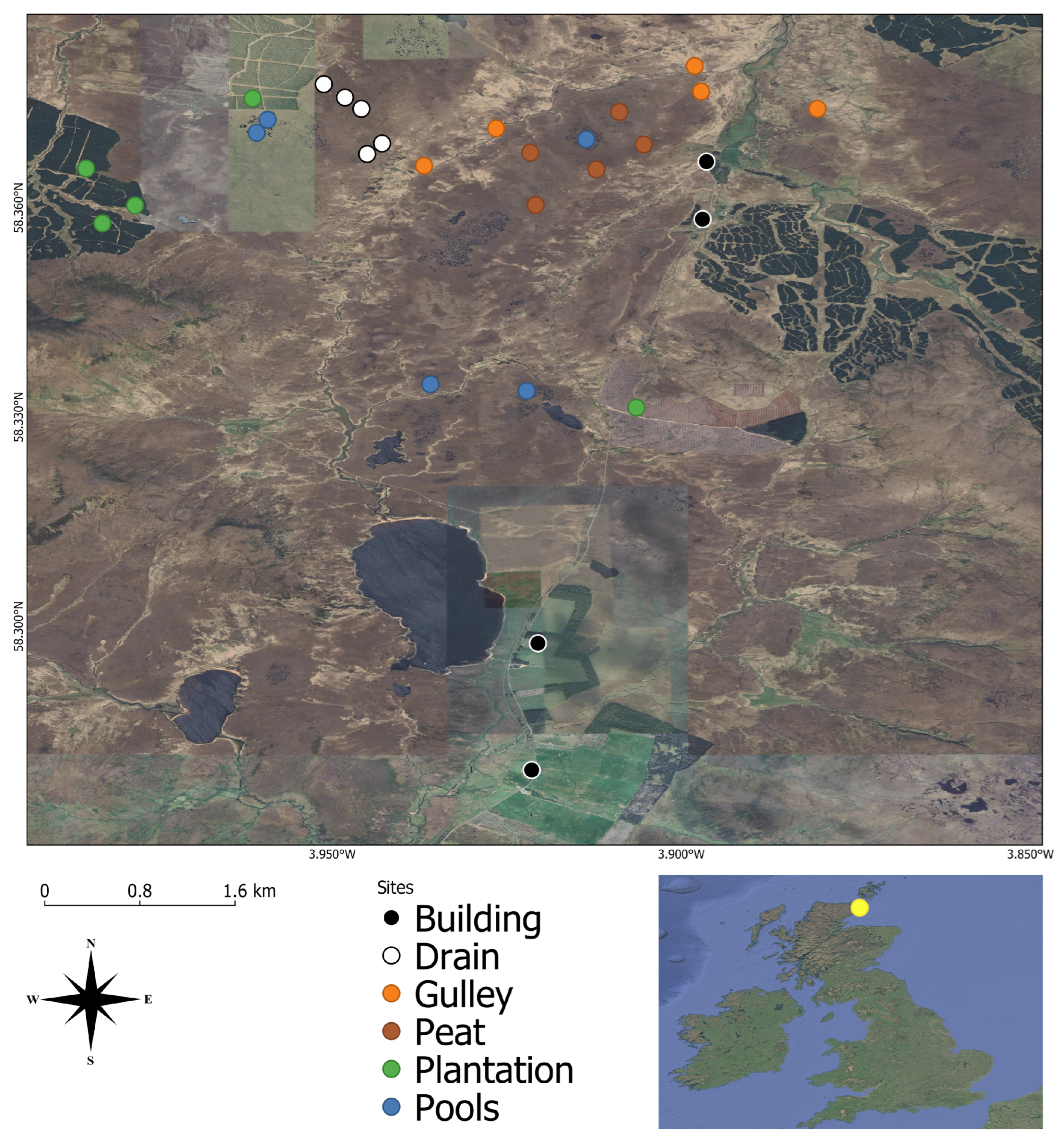
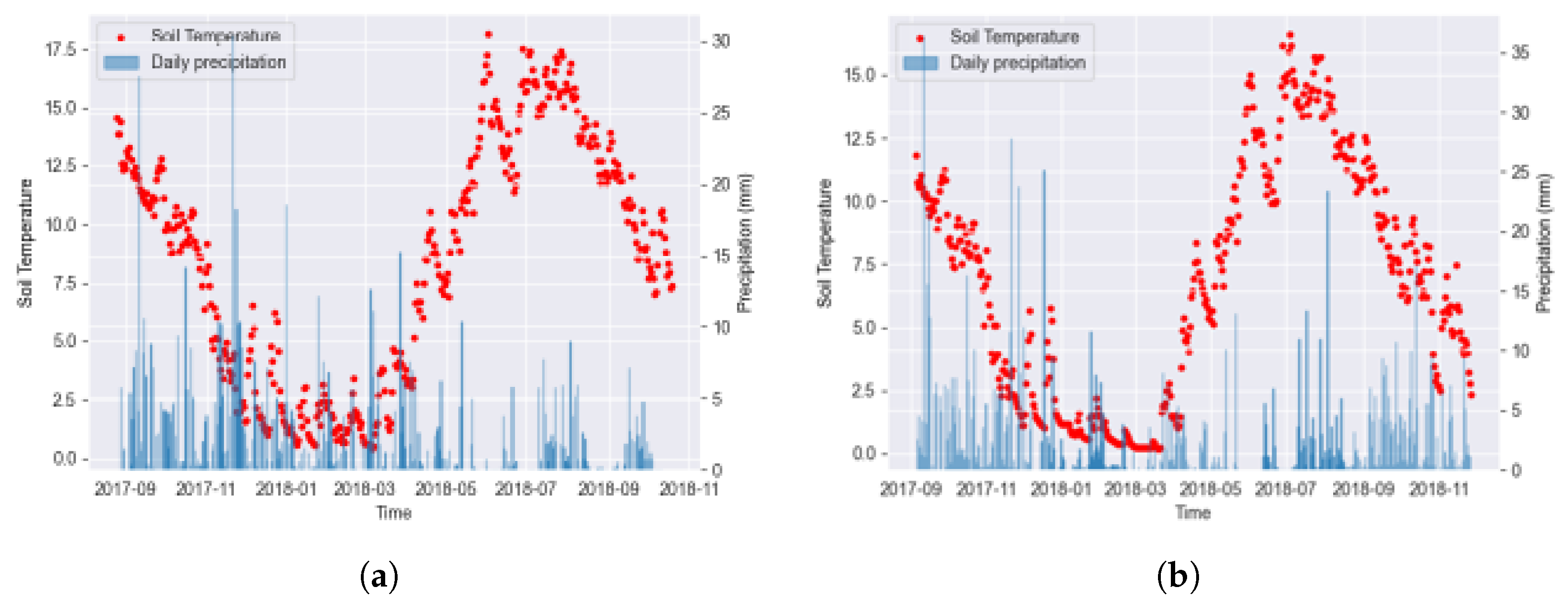
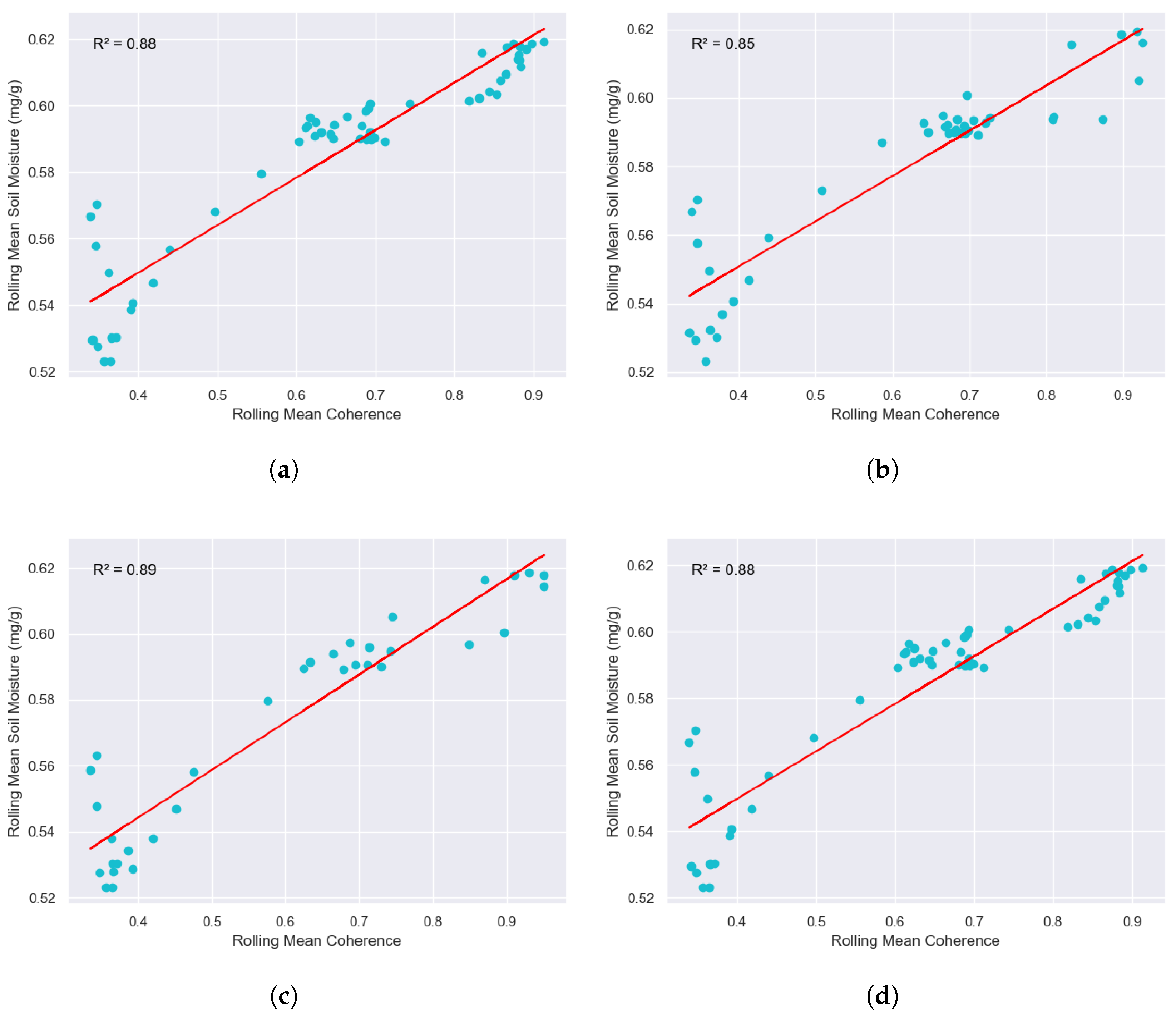
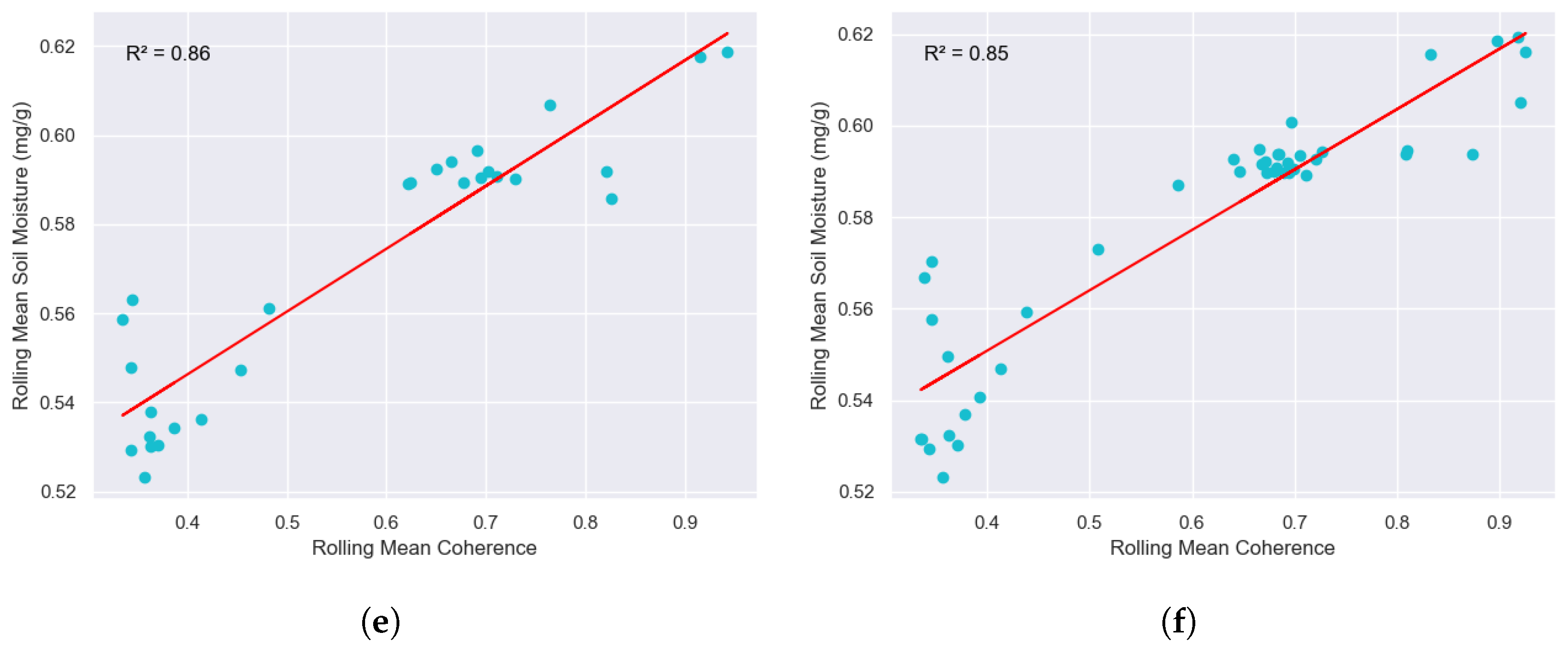
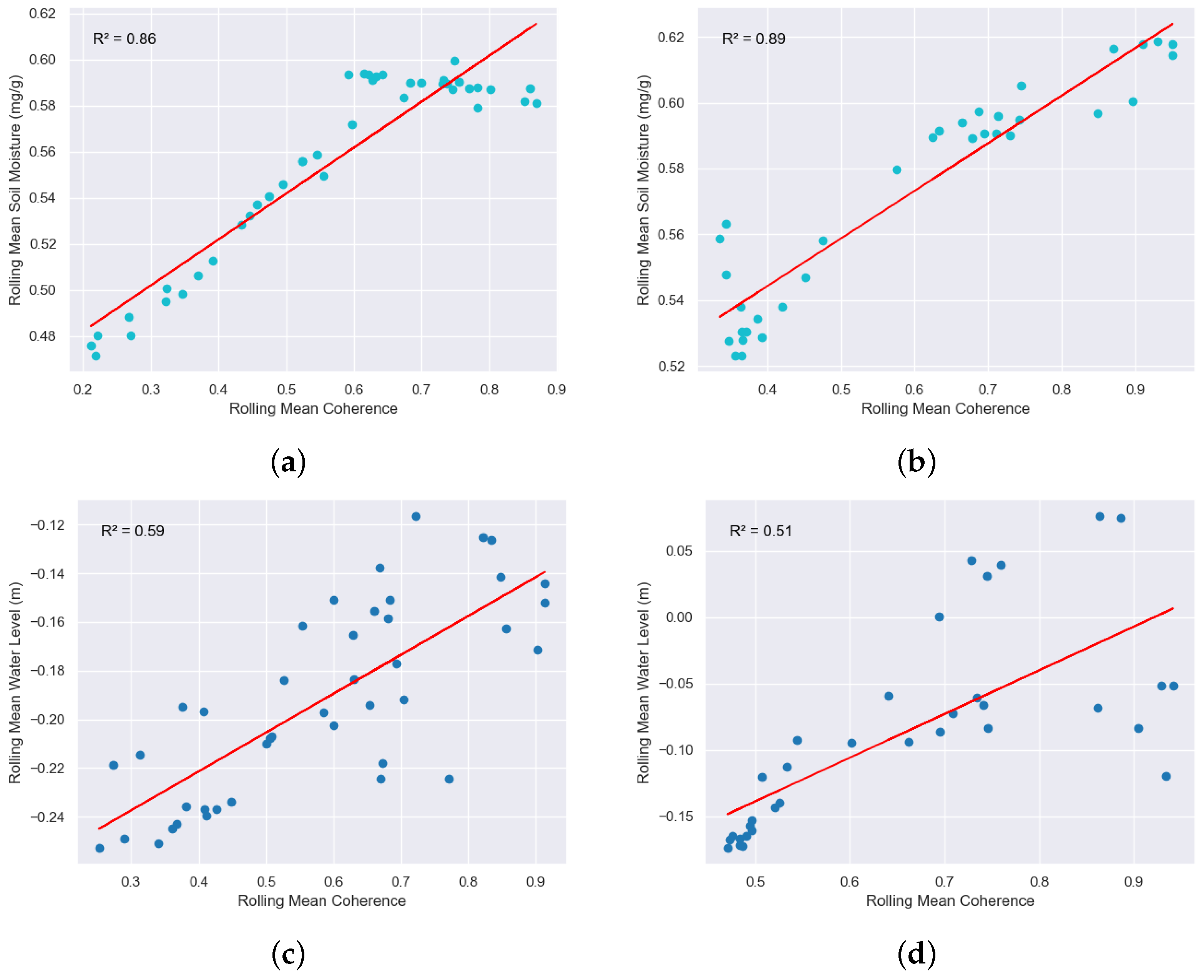
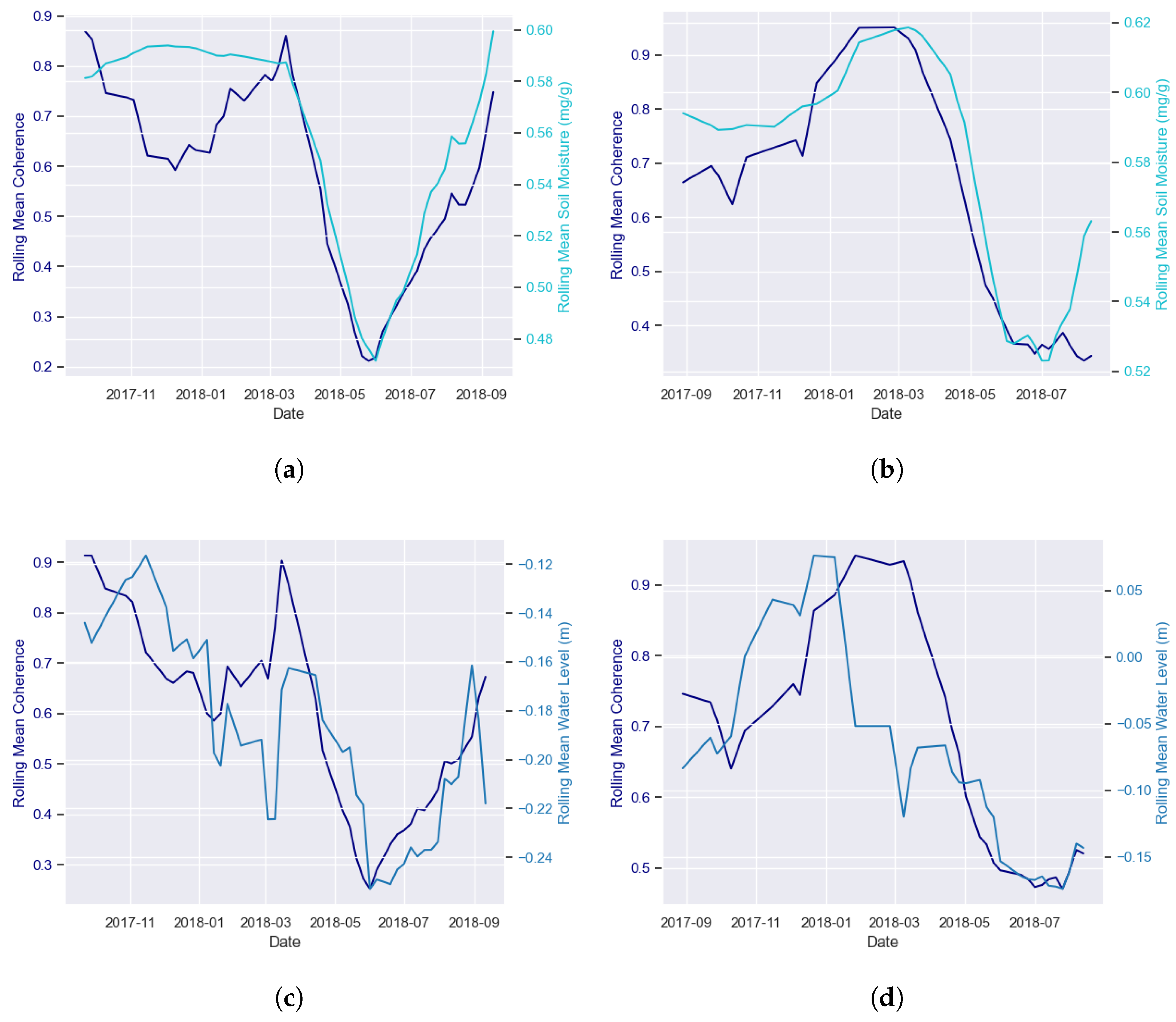


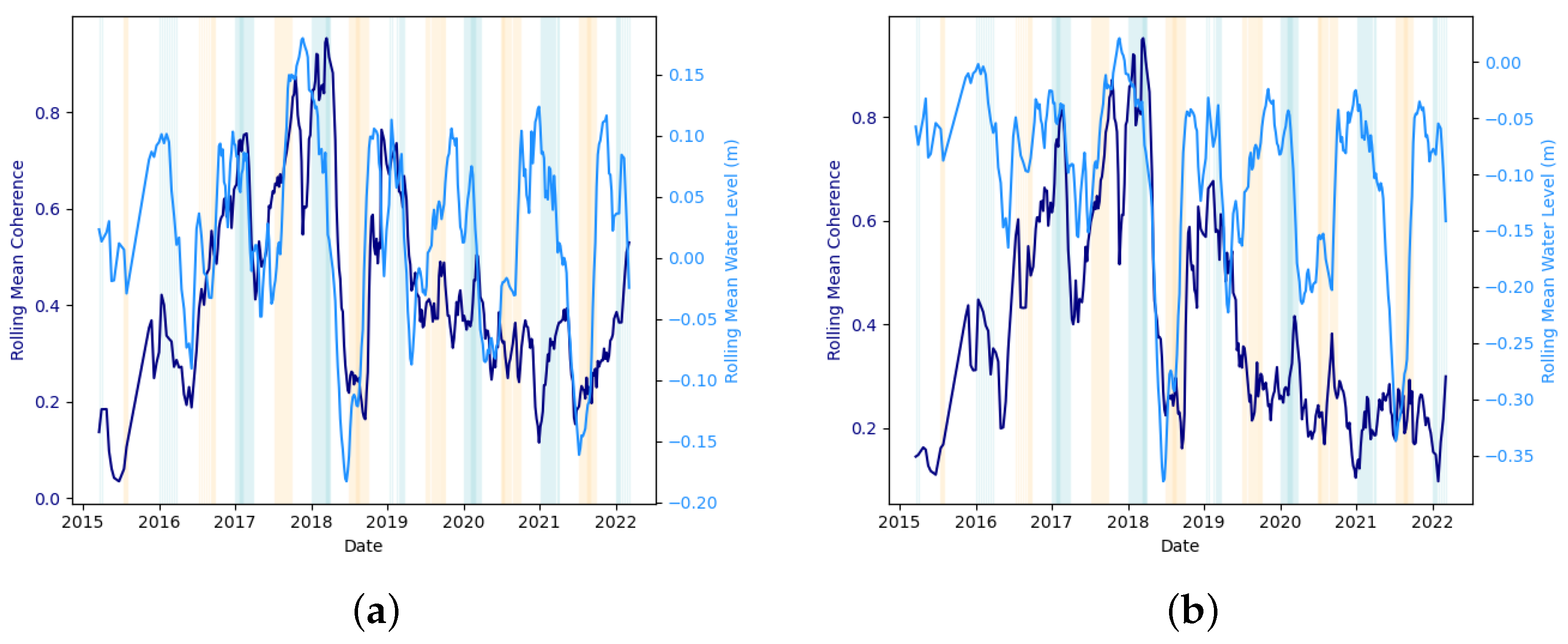

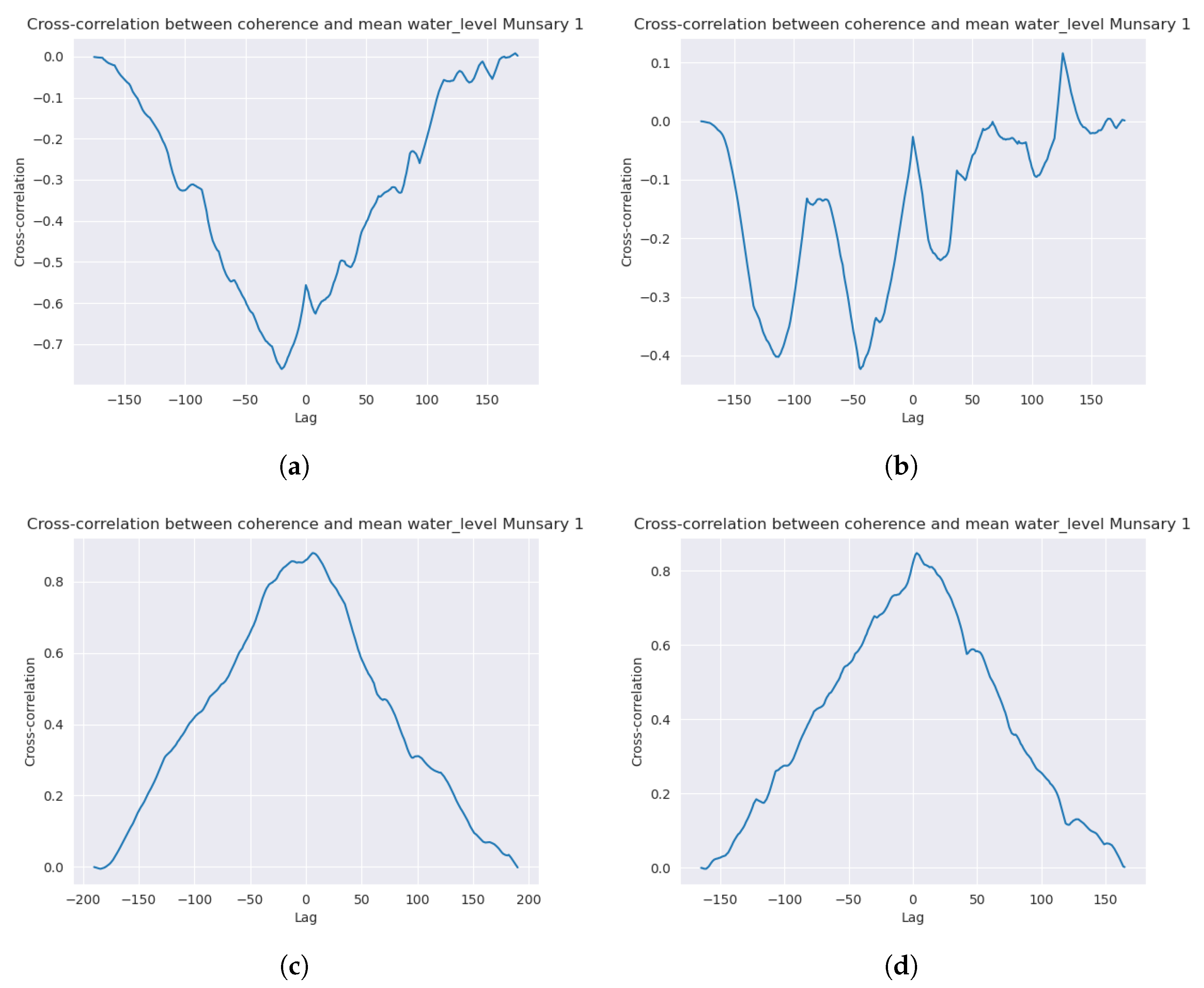
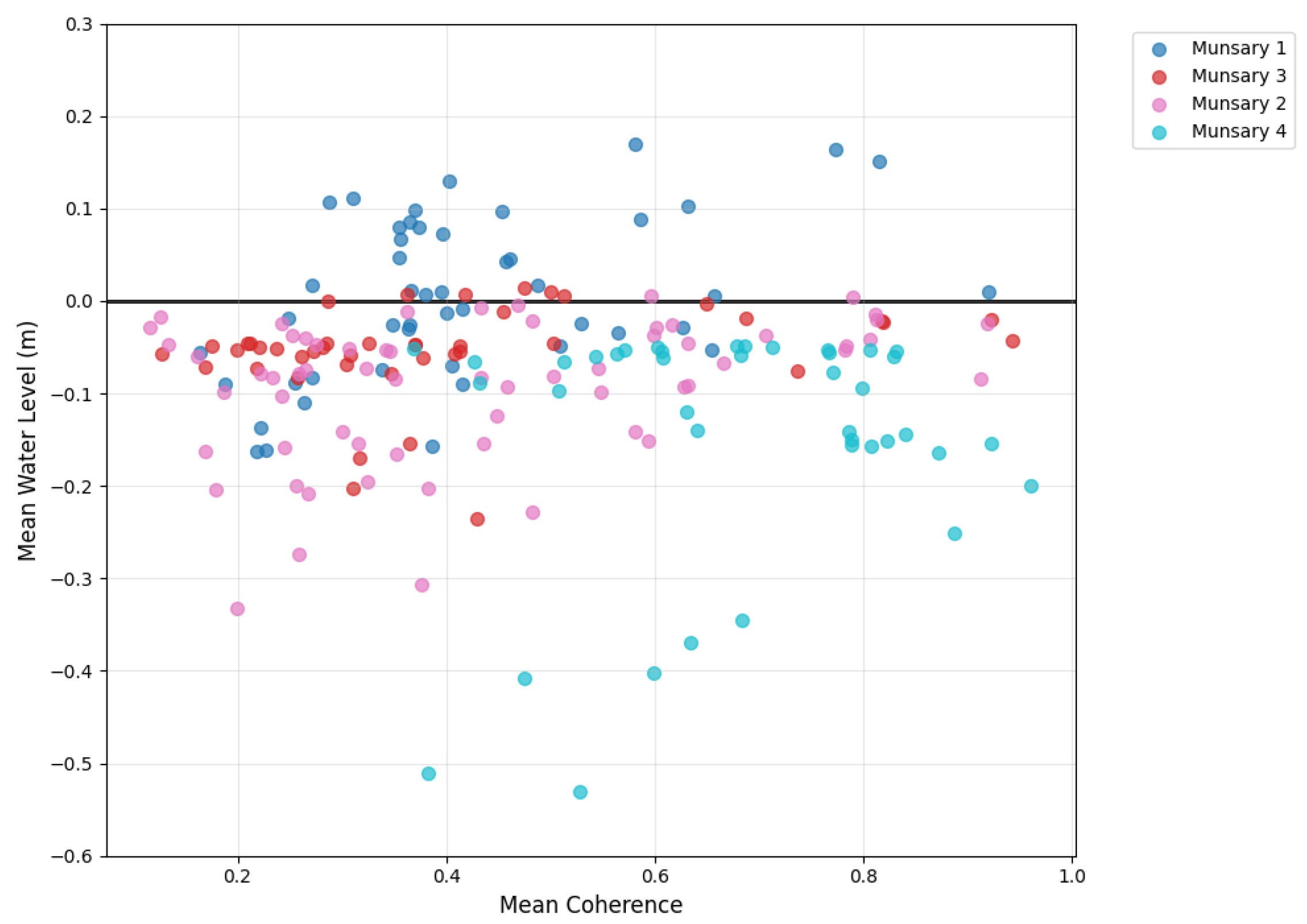
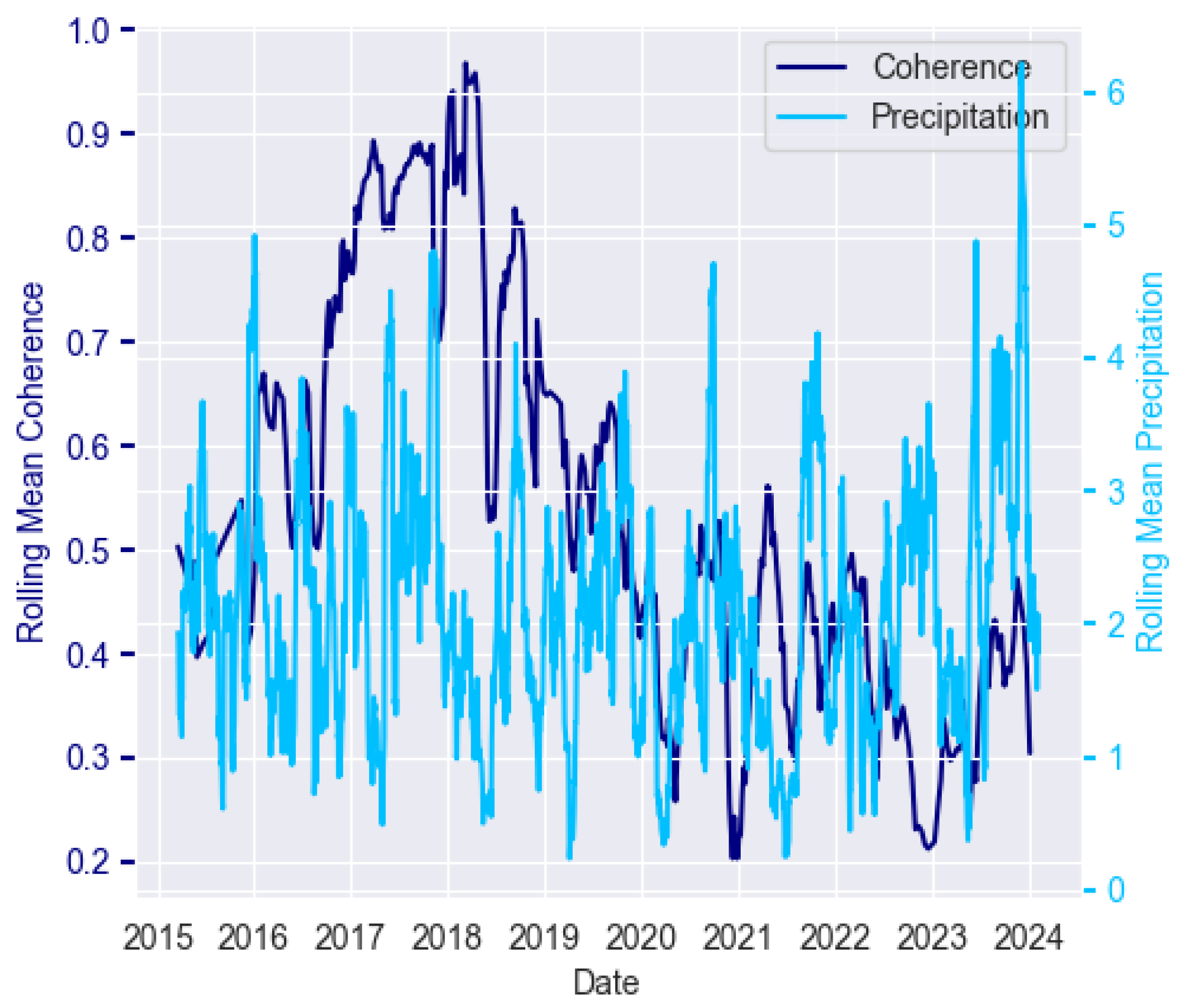
| Aspect of Focus | Parameter |
|---|---|
| Platform | Sentinel 1 |
| Beam Mode | IW |
| Flight Direction | Ascending |
| Relative Orbit | 132 |
| Granule | SLC |
| Looks | 10 × 2 |
| Apply water mask | True |
| Rolling Mean Time Scale | No Data Removed | Precipitation Time | Precipitation Amount | Frozen Soil | Frozen Soil and Amount Precipitation | Frozen Soil and Precipitation Time |
|---|---|---|---|---|---|---|
| Munsary | ||||||
| SM: overall | ||||||
| SM: 2 mths | ||||||
| SM: 6 wks | ||||||
| SM: 1 mth | ||||||
| WL: overall | ||||||
| WL: 2 mths | ||||||
| WL: 6 wks | ||||||
| WL: 1 mth | ||||||
| Knockfin Heights | ||||||
| SM: overall | ||||||
| SM: 2 mths | ||||||
| SM: 6 wks | ||||||
| SM: 1 mth | ||||||
| WL: overall | ||||||
| WL: 2 mths | ||||||
| WL: 6 wks | ||||||
| WL: 1 mth | ||||||
| Variable 1 | r | Variable 2 | r | Fisher’s z | p-Value | Significant |
|---|---|---|---|---|---|---|
| MUN SM ppt time | 0.88 | MUN SM no removal | 0.80 | 3.11 | 0.0018 | Yes |
| KH SM ppt time | 0.81 | KH SM no removal | 0.73 | 2.41 | 0.0160 | Yes |
| MUN WL ppt time | 0.67 | MUN WL no removal | 0.62 | 0.88 | 0.3799 | No |
| KH WL ppt time | 0.62 | KH WL no removal | 0.40 | 3.34 | 0.0008 | Yes |
| MUN SM ppt time | 0.88 | KH SM ppt time | 0.81 | 2.62 | 0.0087 | Yes |
| MUN SM ppt time | 0.88 | MUN WL ppt time | 0.67 | 5.34 | 0.0000 | Yes |
| MUN WL ppt time | 0.67 | KH WL ppt time | 0.62 | 0.82 | 0.4098 | No |
| KH WC ppt time | 0.81 | KH WL ppt time | 0.62 | 4.27 | 0.0000 | Yes |
| Location/Data | No Data Removed | Precipitation Time | Precipitation Amount | Frozen Soil | Frozen Soil and Amount Precipitation | Frozen Soil and Precipitation Time |
|---|---|---|---|---|---|---|
| Whole area | ||||||
| KH Wick | ||||||
| KH local | ||||||
| KH SM | ||||||
| KH WL | ||||||
| MUN Wick | ||||||
| MUN local | ||||||
| MUN SM | ||||||
| MUN WL |
| Site Type | Cross Correlation Range |
|---|---|
| Buildings | 0.89–0.92 |
| Drains | 0.83–0.93 |
| Gulleys | 0.86–0.88 |
| Peat (Forsinard) | 0.88–0.92 |
| Peat (Knockfin Heights) | 0.86–0.92 |
| Peat (Munsary) | 0.86–0.90 |
| Plantations | 0.88–0.90 |
| Pools | 0.86–0.89 |
Disclaimer/Publisher’s Note: The statements, opinions and data contained in all publications are solely those of the individual author(s) and contributor(s) and not of MDPI and/or the editor(s). MDPI and/or the editor(s) disclaim responsibility for any injury to people or property resulting from any ideas, methods, instructions or products referred to in the content. |
© 2025 by the authors. Licensee MDPI, Basel, Switzerland. This article is an open access article distributed under the terms and conditions of the Creative Commons Attribution (CC BY) license (https://creativecommons.org/licenses/by/4.0/).
Share and Cite
Walker, R.Z.; Boyd, D.S.; Andersen, R.; Large, D.J. InSAR Coherence Linked to Soil Moisture, Water Level and Precipitation on a Blanket Peatland in Scotland. Remote Sens. 2025, 17, 3507. https://doi.org/10.3390/rs17213507
Walker RZ, Boyd DS, Andersen R, Large DJ. InSAR Coherence Linked to Soil Moisture, Water Level and Precipitation on a Blanket Peatland in Scotland. Remote Sensing. 2025; 17(21):3507. https://doi.org/10.3390/rs17213507
Chicago/Turabian StyleWalker, Rachel Z., Doreen S. Boyd, Roxane Andersen, and David J. Large. 2025. "InSAR Coherence Linked to Soil Moisture, Water Level and Precipitation on a Blanket Peatland in Scotland" Remote Sensing 17, no. 21: 3507. https://doi.org/10.3390/rs17213507
APA StyleWalker, R. Z., Boyd, D. S., Andersen, R., & Large, D. J. (2025). InSAR Coherence Linked to Soil Moisture, Water Level and Precipitation on a Blanket Peatland in Scotland. Remote Sensing, 17(21), 3507. https://doi.org/10.3390/rs17213507








